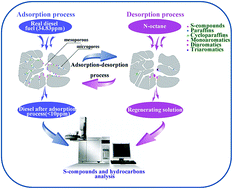Solvent desulfurization regeneration process and analysis of activated carbon for low-sulfur real diesel
Abstract
The adsorption desulfurization process of diesel fuel is suffering from adsorbent regeneration limitation. Adsorption performance of activated carbon (AC) for S-compounds and hydrocarbons in low-sulfur real diesel was investigated by an adsorption fixed bed. The exhausted AC was regenerated by different solvents, including n-octane, ethanol and cyclohexane. AC samples were characterized using N2 adsorption–desorption isotherm at 77 K, TG and FT-IR. S-species and hydrocarbons-species in real diesel and the regeneration solutions were analyzed by gas chromatography-sulfur chemiluminescence detection (GC-SCD), gas chromatography-mass spectrometry (GC-MS) and gas chromatography (GC). The effects of hydrocarbons on desorption performance of S-compounds and extraction capability of n-octane were investigated. The effect of n-octane as a recycled regeneration solvent on the regeneration stability of AC in this work was also considered. The S-content in diesel was reduced to less than 10 ppm from an initial S-content of 34.83 ppm. The competitive adsorption between polycyclic aromatic hydrocarbons (PAHs) and S-compounds was the largest in hydrocarbons. The regeneration performance of different solvents for AC decreased as follows: n-octane > ethanol > cyclohexane. The regeneration efficiency of AC was 100% after a first adsorption–desorption cycle, and was held near 73% after 50 cycles using fresh n-octane as a regenerating solvent. The regeneration efficiency of AC can be maintained at 45% after 20 cycles using n-octane as a recycled regeneration solvent. According to the results of characterizations and tests, we found that multilayer adsorption of S-compounds and PAHs occurred in the mesopores of AC, while the aggregation phenomenon of small alkane molecules mainly existed in the micropores.


 Please wait while we load your content...
Please wait while we load your content...